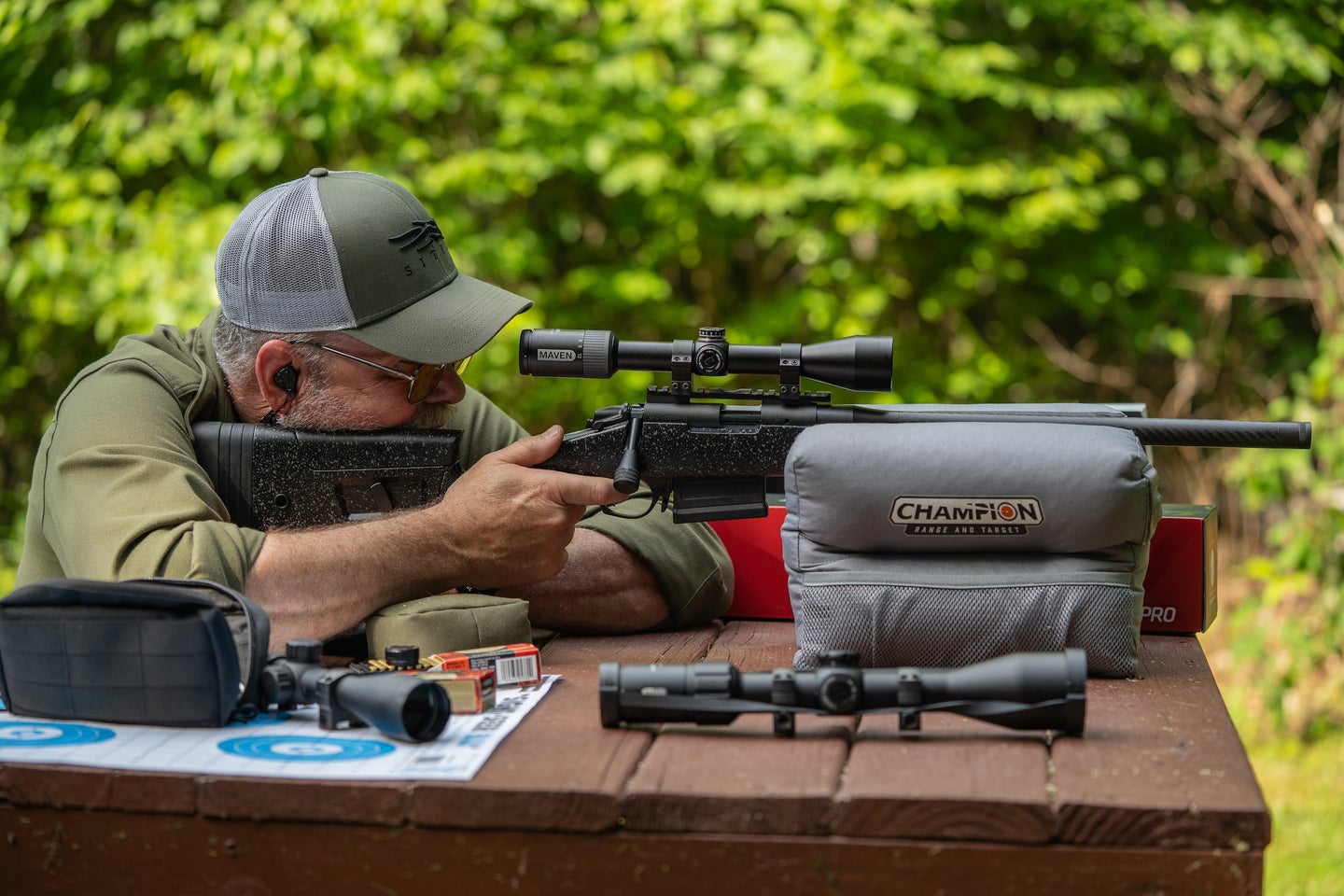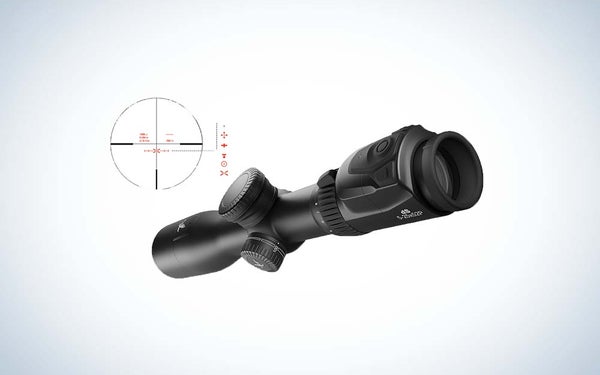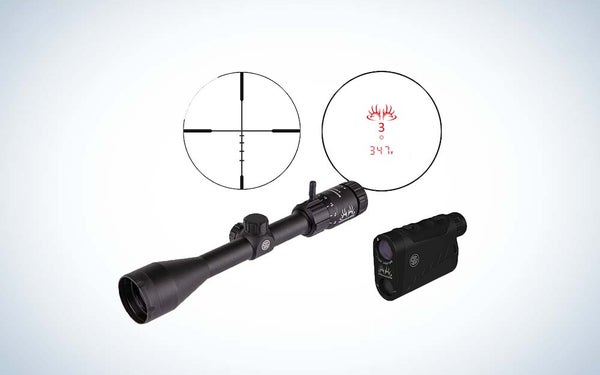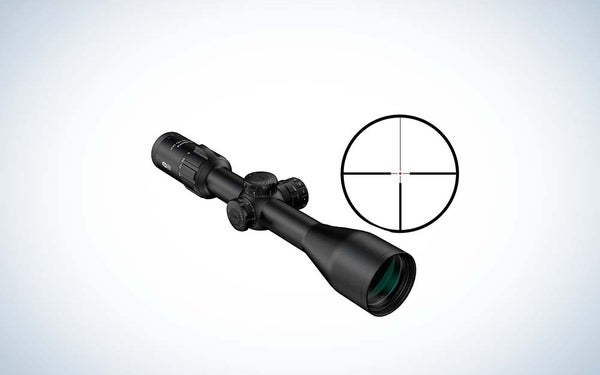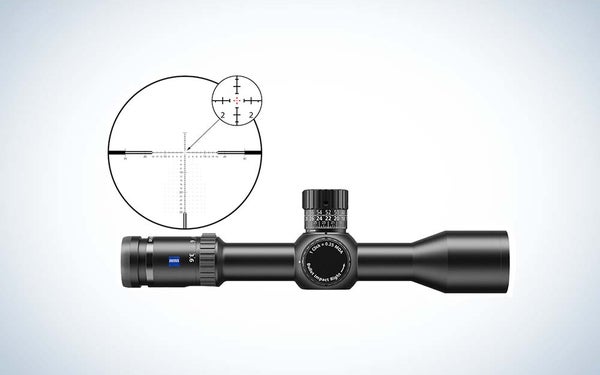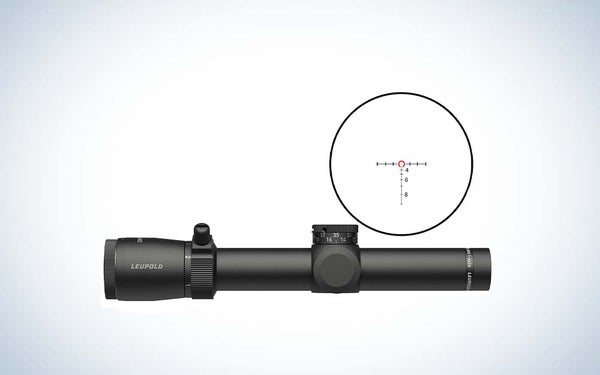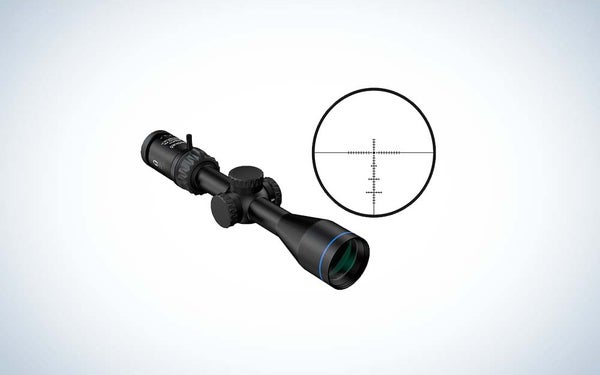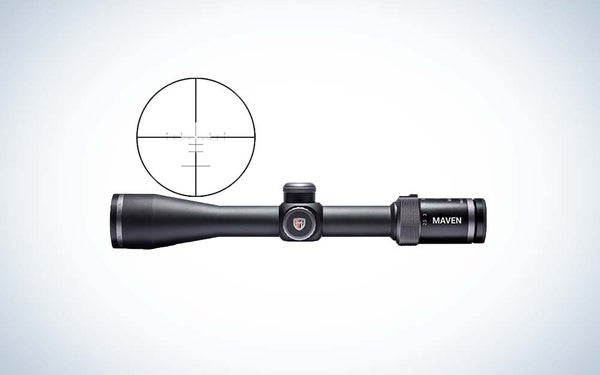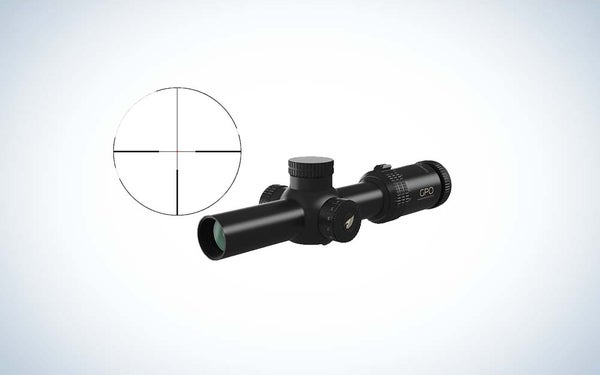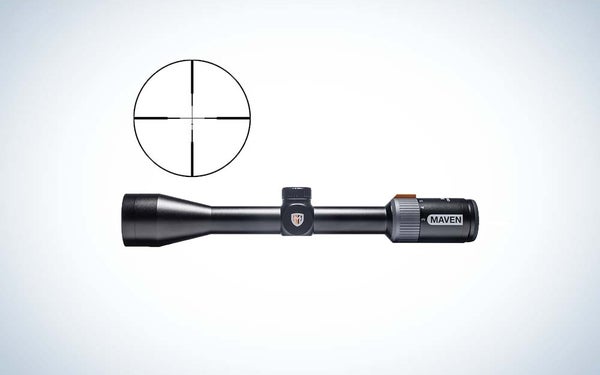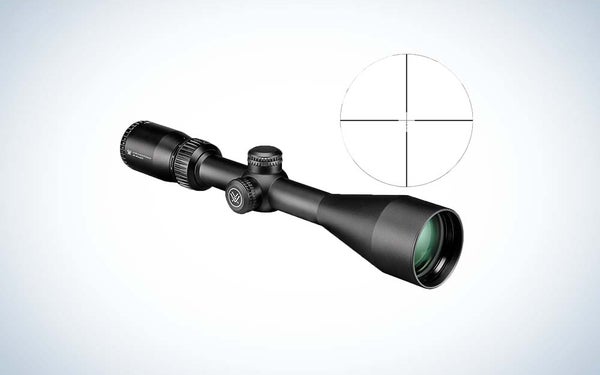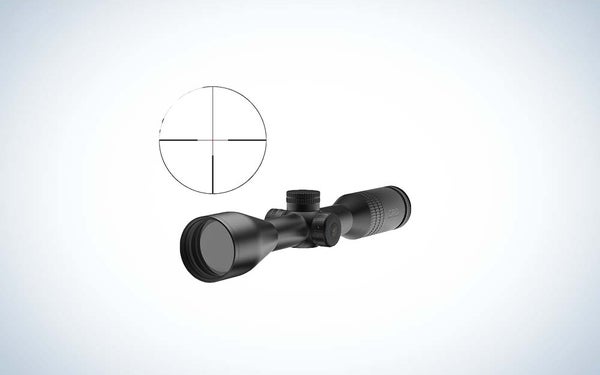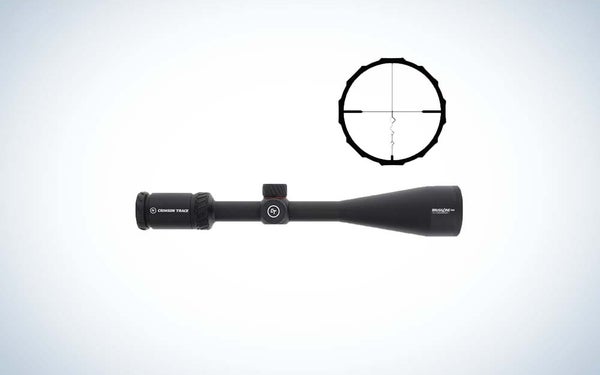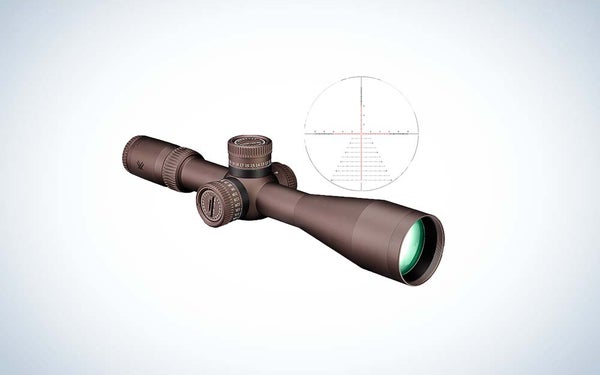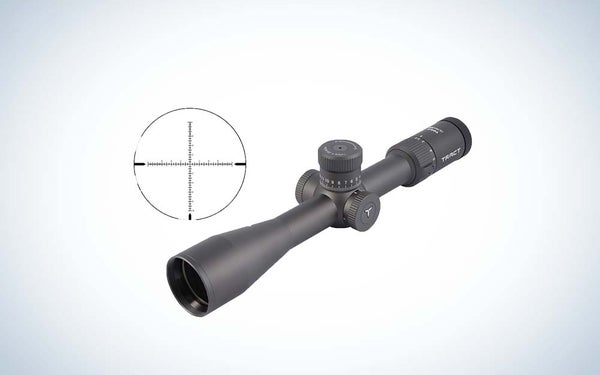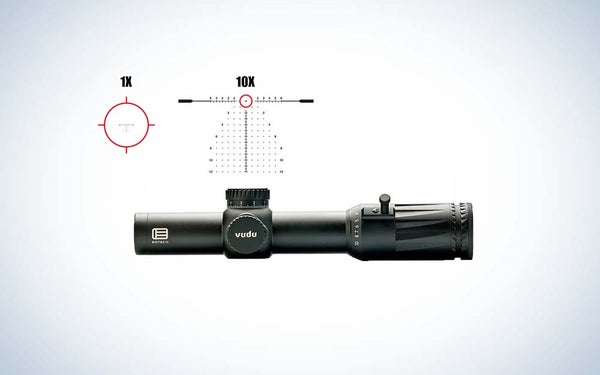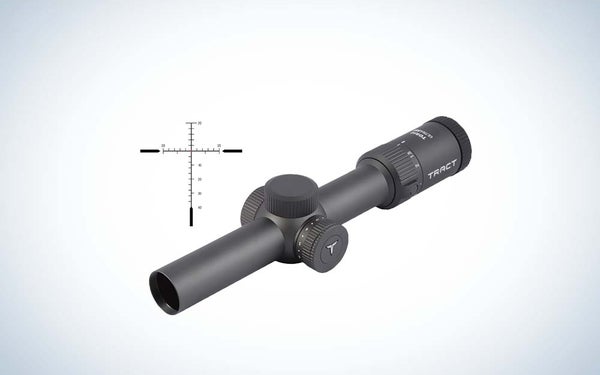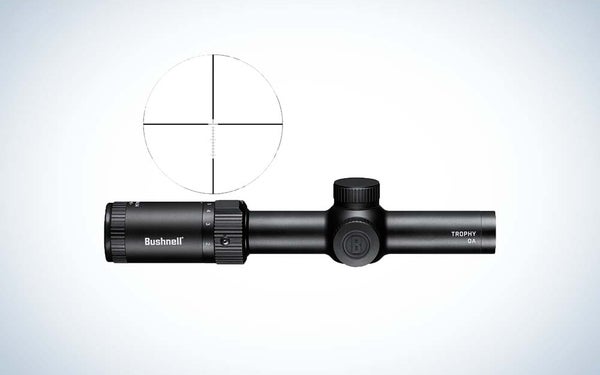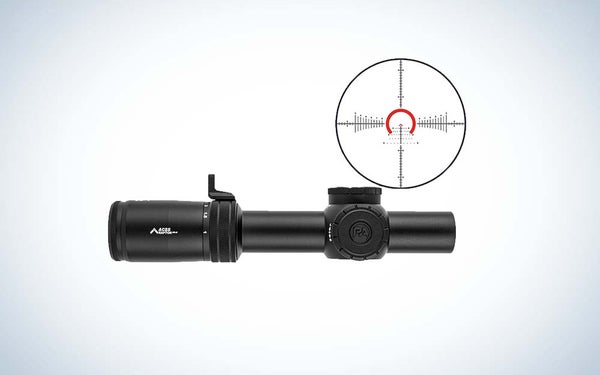| Best Overall |

|
Swarovski ds Gen II 5-12X52 | SEE IT |
LEARN MORE
|
Summary
Hands down, the most advanced hunting rifle scope ever made. |
| Best Value |

|
Sig Sauer Buckmasters 3-9X40mm Combo Kit | SEE IT |
LEARN MORE
|
Summary
The scope’s performance is right there with others in its price range, but this one comes with a rangefinder. |
| Best for Hunting |
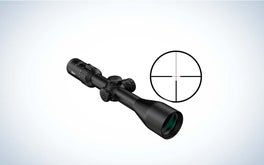
|
MeoSport R 3-15x50 RD SFP | SEE IT |
LEARN MORE
|
Summary
This scope delivered high-end performance and features at a mid-range price. |
We may earn revenue from the products available on this page and participate in affiliate programs. Learn more ›
We’ve come a long way from the old general-purpose 4X fixed and 3-9X variable rifle scopes. The latest models tend to be very specialized, with scopes designed for specific types of hunting, for long-range competition shooting, and for tactical applications. There’s even a model designed for a specific cartridge. Those that do make for good all-around hunting scopes are more sophisticated than ever, too.
To help you choose the best rifle scope for you, we put some of the most popular models through a series of tests to determine how well they perform and if they’re worth the money. The most amazing revelation was not how much better one scope was compared to another, but how well they all performed compared to models of just a handful of years ago.
Every scope I tested—even the most affordable scopes—had repeatedly accurate elevation and windage adjustments and proved tough as hell, even when abused. One thing’s for sure, the best rifle scopes below are nothing like what your grandad or even your father had. They’re much, much better.
The Best Rifle Scopes of 2023
- Best Overall: Swarovski ds Gen II 5-12X52
- Best Value: Sig Sauer Buckmasters 3-9X40mm Combo Kit
- Best for Hunting: MeoSport R 3-15×50 RD SFP
- Best Long-Range Hunting/Target: Zeiss 3-18×50 LRP S5 FFP
- Best Low Power Variable Optic: Leupold Patrol 6HD 1-6X24mm SFP
The Rest of the Best Rifle Scopes of 2023
- Meopta Optika 5 2-10×42
- Maven RS1 2.5-15X44 FFP
- GPO Spectra 8X 1-8X
- Maven CRS.1 3-12X40 SFP
- Vortex Crossfire II Straightwall 3-9X40
- GPO Spectra 7.5×50
- Crimson Trace 4-16X Brushline Pro 6.5 Creedmoor
- Vortex Razor HD Gen III 6-36X
- Tract Toric Ultra HD 2.5-15X44
- EOTECH Vudu 1-10X28 FFP
- Tract Toric UHD 1-8X24 IR LPVO
- Bushnell Trophy Quick Acquisition 1-6X24mm
- Primary Arms Compact PLx 1-8X24mm FFP

How We Tested Rifle Scopes
Accuracy
The primary purpose of a rifle scope is to direct your bullet to the spot you want it to hit. For this to happen, you need to be able to zero the scope precisely, and the scope must maintain that zero. To test the adjustments, my test partner and I mounted every scope to a fine-shooting Bergara B14 Carbon 22 rifle via Leupold rings. Then we zeroed the rifle and scope at 100 yards with Federal Gold Medal Match 22 LR ammo. Once we confirmed that a precise zero was possible, we fired a box drill with every rifle scope. Next, we removed each scope from the rifle and dropped it onto a hard surface from waist high, three times. Afterward, we put the scope back on and checked the zero again.
Clarity
The secondary purpose of a rifle scope is to allow you to see your target clearly. This requires good glass, good lens treatments, and exactness in assembly. For this evaluation, we placed an optics chart, a dollar bill, and a multicolored target in the shade and in good light at 50, 75, and 125 yards. Then we studied these things through each scope to evaluate their brightness, resolution, and image quality.
Durability
A rifle scope must be able to survive the elements, so you can use it in the field no matter how harsh the conditions. For this evaluation, we dunked each scope in 10 inches of water for 30 seconds and then tossed them in the freezer overnight. The next day they were checked for leakage and function.
Ease of Use
Finally, a rifle scope needs to interface well with you. Ideally, all the adjustments and controls should be easy to operate and somewhat intuitive. We tested this with every model, and with any accessories supplied with each scope.

How We Picked the Best Rifle Scopes
Ultimately, we scored each rifle scope on a host of test categories. Depending on the type of scope, some categories were worth more points than others. For example, with the target/long-range hunting scopes, weight was not scored but the preciseness of the adjustments was worth twice what they were with the traditional hunting and LVPO rifle scopes. Similarly, with the long-range/target scopes, the reticle’s usefulness was double-weighted because it is so important in this category.
After testing all the scopes and adding up the scores, we chose our winners. And we reviewed every model below, including the pros and cons for each. Finally, because what you actually aim with is the reticle, and because reticle styles today vary so much, we’ve included images of the reticle for each scope as well.
Best Rifle Scopes: Reviews and Recommendations
Best Overall: Swarovski ds Gen II 5-12X52
Specs
- Score: 98.62
- Magnification Range: 2-25X
- Objective Diameter: 52mm
- Length: 16 inches
- Weight: 38.8 ounces
- Tube Diameter: 40mm
- Reticle: Second Focal Plane
Pros
- Provides firing solutions
- Simplifies long-range shooting
- Integral rangefinder
- This scope is smarter than you
Cons
- Expensive and battery dependent
- Large, heavy, and has an unusual ring size
In some ways, the Swarovski ds Gen II was hard to test and score on a level playing field with the others because it is so new and different. It does not have external adjustments; it does have a built-in rangefinder; it does all the long-range thinking for you; and it cost a hell of a lot of money. That said, given its optical quality, wildly innovative technology, and perfection of performance, it was clearly the best rifle scope in this test and maybe the best ever made.
As such, we had to test it a little differently. Once you zero this rifle scope, you do not need to touch adjustments again, which is why they’re hidden under caps on the objective end. Given that the scope does all your trajectory calculations for you, and the fact that there are no turrets, a box drill was unnecessary. So, we mounted the scope to a Nosler Model 21 in 6.5 Creedmoor, zeroed it, and took it to Bang Steel, a long-range shooting facility, and put it through its paces. I shot at targets of about 12 inches in diameter from 188 yards to 1018 yards—and never missed a single shot. You simply hit the laser button, and one of the 30 available illuminated reticles (you pick the one you want) appears on the bottom vertical reticle wire. You place that reticle on the target and pull the trigger. Some of the available reticles even have wind holds, and the only adjustment you have to make is the parallax.
The Swarovski ds Gen II rifle scope is really in a category all its own. Not only does it give you the correct hold over, but it also tells you the bullet’s time of flight, impact velocity, and impact energy at the ranged distance. As my testing partner best summed it up, “This scope is cool as hell.” It is way too expensive for most hunters and a bit large and heavy. It also requires a smartphone app to initially transfer all the ballistic data. However, if you want to make hitting at long range as simple as possible, this is the scope. This might be too much technology for you, but it is the future.
Best Value: Sig Sauer Buckmasters 3-9X40mm Combo Kit
Specs
- Score: 81.70
- Magnification Range: 3-9X
- Objective Diameter: 40mm
- Length: 12.5 inches
- Weight: 14.3 ounces
- Tube Diameter: 1 inch
- Reticle: Second Focal Plane
Pros
- Ballistic reticle
- Comes with rangefinder
- Compact and lightweight
Cons
- Only 60 MOA of adjustment range
- Small eye box
There was nothing particularly amazing about this rifle scope. It delivered performance you would expect from a $300 optic. Resolution in low and bright light was about average and the eye-box was a bit small, and as a result, head alignment was critical at high magnification. We mounted it in Leupold PPW2 rings, and the adjustments were very precise. It comes with flip up lens covers, zero-resettable turrets, a practical bullet-drop compensating reticle, and a lens cloth. More important, at the amazing price of only $279, this rifle scope comes with a Sig Sauer 6×22 1500 laser rangefinder.
With the rangefinder and the BDC-style reticle, this scope is equipped to take you to 500 yards and beyond. We tested the rangefinder separately out to 1,000 yards, and it performed flawlessly and even better than two other entry level rangefinders we had on hand. With the eight internal ballistic groups in the rangefinder, you should be able to use the scope’s reticle effectively with most popular big-game cartridges. This scope performs on par with others in its price range, so with the included rangefinder, it’s a steal. If there is a downside it’s that both the scope and rangefinder are made in China.
Best for Hunting: MeoSport R 3-15×50 RD SFP
Specs
- Score: 86.25
- Magnification Range: 3-15X
- Objective Diameter: 50mm
- Length: 13.5 inches
- Weight: 22.4 ounces
- Tube Diameter: 30mm
- Reticle: Second Focal Plane
Pros
- Comes with rings
- Large mounting space
- Lifetime transferable warranty
Cons
- Slightly heavy
This Czech-made riflescope was the biggest surprise of the test. At under $500, we expected mid-range performance, but the MeoSport over-delivered. The magnification range is about ideal for big-game hunting. In the European tradition, the adjustments represent 1 centimeter at 100 meters. This can be confusing, but it’s the equivalent of 1/10th MIL at 100 yards/100 meters.
Though the reticle has no assistance for long-range shooting, it is simple, illuminated, and ideal for general hunting, and ballistic corrections can be made with the scope’s external elevation turret, which is zero-resettable and has 90 MOA of adjustment. The scope also has a side-parallax adjustment that is integral to the reticle-brightness knob, which has 11 settings with an off position between each setting. The parallax adjustment works from 10 yards to infinity, which also makes this a great rimfire or air-gun riflescope. Most impressive, this riflescope delivered the best resolution—in low and bright light—of any of the traditional hunting scopes we tested. And it comes with rings too.
Best Long-Range Hunting/Target: Zeiss 3-18×50 LRP S5 FFP
Specs
- Score: 98.47
- Magnification Range: 3-18X
- Objective Diameter: 50mm
- Length: 13.5 inches
- Weight: 32.8 ounces
- Tube Diameter: 34mm
- Reticle: First Focal Plane
Pros
- Fantastic optical quality
- Optimal user interface
Cons
- Heavy
- Expensive
Like these 1,000-yard scopes, this scope is ideally designed for long-range shooting, whether it be at targets or critters. No, it will not determine the range to the target for you like the new Swarovski scope will. However, once you know that range, you can swiftly drive the exposed turrets of this scope for windage and elevation to perfectly direct your reticle based on a ballistic solution you’ve created. An illuminated MIL or MOA reticle that is well suited to down-range ballistic correction is available. Image resolution was exceptional, the adjustments were perfection, and there is a 140 MOA or 40.7 MRAD of adjustment available.
Like most first-focal-plane high-magnification rifle scopes, the reticle was a bit hard to see at low magnification in low light. However, the illuminated portion of the reticle will compensate in those conditions, and a throw lever is standard issue. It is, like all scopes of this ilk, a bit heavy, but at only 13.5 inches long, it is very compact. User interface was exceptional, and the police sniper assisting with testing said this German-made optic was the best long-range hunting/target scope he’d ever looked through. When all the rifle scopes were removed from the freezer, this scope was only one of two that you could see through well enough to use.
Best Low Power Variable Optic: Leupold Patrol 6HD 1-6X24mm SFP
Specs
- Score: 87.72
- Magnification Range: 1-6X
- Objective Diameter: 24mm
- Length: 10.75 inches
- Weight: 15.0 ounces
- Tube Diameter: 30mm
- Reticle: Second Focal Plane
Pros
- Excellent reticle for close-range and distance shooting
- Custom elevation turret compatibility
Cons
- Limited illumination adjustment
- Reticle configured for specific cartridge
Leupold’s newest rifle scope was not only the lightest LPVO we tested; it was only 7/10ths of an ounce heavier than the lightest rifle scope we tested. It was also only one of two scopes that came out of the freezer, useable. We mounted this scope in Leupold Mark 4 rings, and the adjustments proved perfectly repeatable on the box drill. The resolution test showed all the LPVOs to be very similar, but this scope’s edge-to-edge image quality was a bit better.
The Patrol 6HD was the only test scope made in the USA, and it comes with a removable throw lever, flip-up lens covers, and Leupold’s unique locking CDS elevation turret, which allows you to set the turret to zero after sighting in, as well as the option to order custom dials pre-calibrated for the trajectory of your load. One of the best features of this scope is the CMR2 reticle. It features an upside-down horseshoe that’s illuminated for up-close, fast-action shooting, but it also has a BDC style vertical post calibrated out to 800 meters for a .223 Rem/5.56 NATO with a 62-grain bullet at 2810 fps. That said, with some math and range time this reticle could work for other cartridges as well.
More of the Best Traditional Hunting Scopes
These scopes are traditional in that they all feature conventional or ballistic reticles and have magnification ranges that are typical for big-game hunting. Most also have covered adjustment turrets and second-focal-plane reticles. What makes them somewhat untraditional as a group, though, is how varied they are, reflecting the specialization we’re now seeing in modern rifle scopes.
Meopta Optika 5 2-10×42 (83.56)
Specs
- Score: 83.56
- Magnification Range: 2-10X
- Objective Diameter: 42mm
- Length: 12.0 inches
- Weight: 21.5 ounces
- Tube Diameter: 1 inch
- Reticle: Second Focal Plane
Pros
- Affordable
- Transferable lifetime warranty
Cons
- Slightly fine reticle for general hunting
This rifle scope comes with a lens cloth, a removable throw lever, and solid lens covers. The magnification range is well suited to all-around big-game hunting, and the scope is only 12 inches long and has 5 1/8 inches of mounting space. At 21.5 ounces, it is a tad heavy, and the ocular housing is a bit large. However, it was one of the few scopes where the magnification setting was easy to see from behind the scope. We mounted it in Leupold Mark 4 rings and the ¼-MOA adjustments were as precise as any rifle scope we tested. The windage and elevation turrets are also resettable to zero.
Resolution in low and bright light was about average the Optika, but the user interface wasn’t; we gave it a perfect score. The Z-Plus MOA reticle is a bit fine for low-light applications, but it does offer windage and elevation corrections, and the subtensions are expertly detailed (in MOA and MRAD) on the website and the instruction manual. The Optika 5 has a lot to offer for its $400 price tag, including a transferable lifetime warranty.
Maven RS1 2.5-15X44 FFP
Specs
- Score: 81.32
- Magnification Range: 2.5-15X
- Objective Diameter: 44mm
- Length: 14.25 inches
- Weight: 24.9 ounces
- Tube Diameter: 30mm
- Reticle: First Focal Plane
Pros
- Parallax adjustment
- Practical long-range reticle
- Lots of mounting space
Cons
- Costs more than a grand
In bright light, the RS1 delivered resolution that was second to none among the hunting scopes tested. In low light, the resolution was about average. This was the only hunting scope we tested with a first-focal-plane reticle, which is preferred by most hunters who plan to shoot at longer ranges. Like most such reticles, however, it was a little difficult to see at low magnification, especially in low light. That aside, it offers a lot of additional aiming points in 1-MOA subtensions for use at distance and is easy to use once you read the well-written manual. And, since this is a first-focal-plane scope, those subtensions are consistent regardless of magnification.
Overall, this is an extremely robust and well-built rifle scope. The capped ¼-MOA adjustment turrets can be reset to zero, and the scope has a parallax adjustment knob. And its 6.25 inches of available mounting space was the most on any hunting scopes tested. This RSI is made in Japan, and like all Maven optics, it comes with a lifetime warranty.
GPO Spectra 8X 1-8X
Specs
- Score: 80.99
- Magnification Range: 1-8X
- Objective Diameter: 30mm
- Length: 10.0 inches
- Weight: 17.3 ounces
- Tube Diameter: 30mm
- Reticle: Second focal plane
Pros
- Great illuminated reticle for hunting dangerous game
- Flip-up lens covers
Cons
- Eye relief is a bit short for hard-kicking rifles
- Confusing adjustments
Specifically made for use with a dangerous-game rifle, this scope has the ideal magnification range for close-range shooting or precision work at modest distances. Resolution in bright and low light was about average compared to the other hunting scopes we tested. Mounted in Leupold Mark 4 rings, the scope’s adjustment repeatability was good, with each click equal to 1 MRAD/1/10th of a MIL at 100 yards, and there was plenty of adjustment available.
As a dangerous-game rifle scope, the Spectra 8X is almost ideal. It has 3.5 inches of eye relief, but another 1/2-inch would be appreciated on hard-kicking rifles. With its 30mm objective lens, it could also serve well on a lever-action rifle, as it can be mounted reasonably low. As with the other GPO scope we tested, the adjustments for this scope were in the opposite direction of what is common, and in centimeters at 100 meters (as opposed to inches at 100 yards). Both are easy enough to figure out but not intuitive for most American shooters. The Spectra 8X comes with the standard GPO lifetime warranty.
Maven CRS.1 3-12X40 SFP
Specs
- Score: 80.91
- Magnification Range: 3-12X
- Objective Diameter: 40mm
- Length: 12.5 inches
- Weight: 14.3 ounces
- Tube Diameter: 1 inch
- Reticle: Second focal plane
Pros
- Very nice reticle for hunting
Cons
- Limited adjustment range
This CRS.1 is a Japanese-made second-focal-plane rifle scope with a SHR (Simplified Hold Over) reticle, which we felt was one of the best for a traditional hunting scope. It was bold enough to see in low light and offers three additional hold-over marks. The adjustments offered 63 MOA of movement, which proved a bit skimpy. After we mounted it to the Bergara B-14 in Leupold PPW2 rings, we ran out of windage adjustment while attempting the 38 clicks to the right during the box drill. Optical resolution in bright light was exceptional, in low light it was average, and mounting space was very generous at 6 inches.
For the price, this scope offers a good value, and it’s not too big or heavy. The ocular housing was not overly large, and the power indicator did not extend so far that it would interfere with most bolt handles during operation. The scope comes with a very nice, padded cover. For general big-game hunting or predator calling inside 400 yards, this scope should satisfy, and it has a lifetime warranty.
Vortex Crossfire II Straightwall 3-9X40
Specs
- Score: 80.83
- Magnification Range: 3-9X
- Objective Diameter: 42mm
- Length: 13.0 inches
- Weight: 17.3 ounces
- Tube Diameter: 1 inch
- Reticle: Second focal plane
Pros
- Reticle tuned to straightwall cartridges
Cons
- Small Eye Box
Piggy-backing on the rising popularity of straightwall cartridges for hunting deer in certain states, this Vortex rifle scope has been configured specifically for that purpose. It features a new ballistic-drop compensating reticle that has been tuned to work with popular straightwall cartridges like the .450 Bushmaster, .350 Legend, and .45-70 Government. Resolution in low and bright light was about average. The adjustments were reasonably accurate but the ¼-MOA clicks were hardly audible. The eye box, especially at high magnification, was a little small.
Overall, if you plan to hunt in a state where straightwall cartridges are required for deer hunting, this scope, with the specialized reticle, makes a lot of sense, and it comes with a good user manual. Overall quality is about what you would expect from a $200 optic, and it is reasonably light and compact. This scope is manufactured in China but comes with a lifetime warranty.
GPO Spectra 7.5×50
Specs
- Score: 80.09
- Magnification Range: 7.5X
- Objective Diameter: 50mm
- Length: 13.5 inches
- Weight: 21.7 ounces
- Tube Diameter: 30mm
Pros
- Great low-light reticle
- Good low-light performance
Cons
- Fixed power
- Confusing adjustments
This is the only fixed-power scope in the test, and with a magnification of 7.5X and a standard reticle, its application is somewhat limited. In Europe, where low-light or night hunting is popular, so too should this scope be. That said, the Spectra would also excel for hunting in the States out to 300 yards or so in dim conditions. In our resolution test, it performed better than average, and it did well in bright light too. The adjustments were exceptionally precise but may be a bit confusing for some, as one click offers 1 centimeter of adjustment at 100 meters, which is the same as 1/10th of a MIL. The adjustments were also in the opposite direction of what is common.
The illuminated rheostat-controlled reticle in the rifle scope was magnificent for low-light shooting. There is 170+ inches of adjustment at 100 meters. GPO riflescopes are built in some of the world’s best optics factories with quality control conducted in Germany, and they come with a lifetime warranty.
Crimson Trace 4-16X Brushline Pro 6.5 Creedmoor
Specs
- Score: 80.91
- Magnification Range: 4-16X
- Objective Diameter: 50mm
- Length: 14.75 inches
- Weight: 20.6 ounces
- Tube Diameter: 1 inch
- Reticle: Second focal plane
Pros
- Multi-point ballistic reticle
Cons
- Average low-light performance
- Limited adjustment range
Made in the Philippines, this 6.5 Creedmoor rifle scope was made to take advantage of the Creedmoor’s spectacular rise, with a ballistic reticle featuring 13 hold over marks tuned for a 140-grain 6.5 Creedmoor load with a muzzle velocity of 2710 fps. Obviously, the ballistic coefficient of 140-grain 6.5mm bullets will vary, but as with any BDC-style reticle, slightly tuning the zero will allow it to reasonably match bullet trajectory. In bright light, the scope had good resolution, but in low light it was average. With only 56 MOA of adjustment, the scope ran out of windage clicks when we attempted the box drill.
With a reticle that should take you to 600 yards or so, it is nice that the scope comes with a parallax adjustment. Although the reticle could be adaptable to other cartridges, at least to some distance, this is a scope purpose-built for the 6.5 Creedmoor. Considering its 1-inch tube, the scope is a tad on the long and heavy side, but it does offer 5.75 inches of mounting space which is nice. If you’re looking for an affordable way to get the most from your Creed, this scope is a decent option. It comes with reticle instructions, scope covers, a lens cloth, and a lifetime warranty.
More of the Best Long Range Hunting/Target Scopes
The scopes in this category have exposed adjustment turrets, MOA or MIL reticles, an external parallax adjustment, a zero stop, and a first-focal-plane reticle. While these riflescopes can be used for hunting, they are ideally configured for long-range precision target shooting. And because they are almost always mounted on rails and on heavy rifles, mounting space and weight were not scored.
Vortex Razor HD Gen III 6-36X
Specs
- Score: 94.27
- Magnification Range: 6-36X
- Objective Diameter: 56mm
- Length: 15.5 inches
- Weight: 42.0 ounces
- Tube Diameter: 34mm
- Reticle: First focal plane
Pros
- Great user interface
- Extremely precise and audible adjustments
Cons
- Heavy and expensive
- Low-light resolution could have been better
Of all the rifle scopes we tested, this one offered the most magnification. Because of this, at maximum power the eye box was small and at the lowest power, the reticle was almost invisible. In terms of optical quality, the Razor HD Gen III was very good, though resolution in low light was not up to par with the other scopes in this category. Other than that, and the fact this scope weighed more than 2.5 pounds, it was fantastic. (Weight was not scored in this category, but a 2.5-pound rifle scope is, by any measure, heavy as hell.)
What really stood out on this Japanese-made optic was its excellent user interface. The unique zeroing and zero-stop feature is intuitive and friendly. The turrets are massive and easy to see and manipulate. The packaging was rather sophisticated, and included in the box were an extra battery, a throw lever, a sunshade, and all the necessary wrenches for scope adjustment. The reticle-illumination adjustment is well designed and can be locked at the setting you desire. The layout of the scope is well thought out, and you can see the power setting indicator from behind the rifle scope. And the EBR-7D reticle is well engineered for long-range application.
Tract Toric Ultra HD 2.5-15X44
Specs
- Score: 94.00
- Magnification Range: 2.5-15X
- Objective Diameter: 50mm
- Length: 14.25 inches
- Weight: 28.0 ounces
- Tube Diameter: 30mm
- Reticle: First focal plane
Pros
- Affordable by long-range scope standards
- Practical for the hunter
Cons
- Capped windage turret
Of all the long-range/target scopes tested, this was the least expensive, by far. But that did not affect this scope’s performance. And price wasn’t the only way in which the Toric stood out in this category. With its smaller size, lighter weight, lower magnification range, and capped windage adjustment, this is the most practical long-range model for hunting. It was also the only scope in the category that did not have an illuminated reticle.
Image resolution was exceptional, click value and repeatability was superb, and an optional zero stop is included. The scope has a side parallax adjustment, 100 MOA of available elevation movement, and the elevation turret is of the pull-up/locking style, with numbers that are easy to see from behind the riflescope. While the first-focal-plane reticle gets very small at lower magnification, the bold outside lines makes it moderately useable in low light. This scope is priced right and offers a great minimalist option for the long-range shooter. Made in Japan, Toric comes with a screw-in sunshade and a no-time-limit, no paperwork, lifetime warranty.
Best Low Power Variable Optics (LPVO)
LPVOs have become very popular in recent years and offer the combined benefits of a red-dot sight and a low-power magnified scope. They are designed primarily for use with MSRs but can be very handy on any lightweight, carbine rifle. Compact and lightweight, they are configured for close-range work with both eyes open for fast target acquisition, as well as for moderate-range targets, typically with some ballistic assistance from the reticle.
EOTECH Vudu 1-10X28 FFP $1800
Specs
- Score: 85.31
- Magnification Range: 1-10X
- Objective Diameter: 24mmmm
- Length: 10.5 inches
- Weight: 20.10 ounces
- Tube Diameter: 34mm
- Reticle: First Focal Plane
Pros
- Versatile illuminated reticle
- Locking and exposed elevation turret, capped windage turret
Cons
- Heavy
- Expensive
- Supplied with cheap lens covers
This is a fantastic LPVO but its score suffered because of price and weight. It costs 28 percent and weighs 33 percent more than the Leupold. But the EOTECH Vudu still has a lot going for it. Mounted in Leupold PPW2 rings we found the 0.1 MRAD adjustments to be perfectly precise, and the scope offers 29 MRAD of elevation and 23 MRAD of windage adjustment. And while the SR-5 MRAD reticle was a bit hard to use at low magnification, with illumination it was fantastic for both-eyes-open snap shooting up close or for precision work at distance. To use the full reticle we found we needed between 5X and 6X of magnification. The Vudu is made in Japan and offered with either a MOA or MIL reticle.
One of the neatest features on the Vudu is the control for the illuminated reticle. On the left of the scope saddle, there is an extended turret that contains the battery. On top and to the front and rear of this turret are rubber-covered buttons that turn the reticle on and control brightness. We found this system very easy and intuitive to manipulate. This scope comes with an optional throw lever and while it is not marketed as a dangerous game or hunting scope, it could for sure fill that role.
Tract Toric UHD 1-8X24 IR LPVO
Specs
- Score: 82.90
- Magnification Range: 1-8X
- Objective Diameter: 24mm
- Length: 11 inches
- Weight: 19.9 ounces
- Tube Diameter: 30mm
- Reticle: Second Focal Plane
Pros
- Excellent reticle for close and distance shooting
- Crossover application
Cons
- Heavy
This is one of the LVPOs that we thought would make a good crossover scope for tactical, sport shooting, and hunting applications. It has an etched MOA reticle with MOA adjustments, but a MIL version is also available. The reticle has an illuminated center dot with 10 different intensity settings with an off switch between each setting. At almost 20 ounces we thought the scope was a bit heavy, but it felt tough and rugged in hand. We found eye relief to be good but at max magnification, the eye box was small requiring the shooter to position their head exactly behind the scope. Edge-to-edge clarity was exceptional and the resolution was on par with the other LPVOs we tested.
This is a Japanese-made rifle scope that comes with 120 MOA of adjustment, ½ MOA click values, and zero-resettable turrets. The scope offers almost seven inches of mounting space. While this wouldn’t matter on an AR15, it would be appreciated and work very well on a dangerous game or large-caliber safari rifle. It comes with a lifetime, no questions asked, warranty.
Bushnell Trophy Quick Acquisition 1-6X24mm
Specs
- Score: 82.00
- Magnification Range: 1-8X
- Objective Diameter: 24mm
- Length: 10.75 inches
- Weight: 18.0 ounces
- Tube Diameter: 30mm
- Reticle: Second Focal Plane
Pros
- Versatile application/Crossover scope
- Excellent value
Cons
- Reticle could have been bolder with fewer subtension marks
- Not perfectly repeatable
Bushnell is marketing this LPVO as a hunting scope. But we felt it would work equally well on a carbine for tactical or sport-shooting applications. Either way, when compared to the rest of the LPVOs tested, this scope is a hell of a bargain. It cost 1/6th of the next most expensive. Mounted in Leupold Mark 4 rings we did find the adjustments to not be perfectly repeatable, but given that this is not a click-as-you-go rifle scope, it was not that big of a deal. The scope zeroed easily and held zero even through the drop test.
The Drop Dot reticle on this scope has an illuminated center dot with six brightness levels and an off setting between each. It also has 11 additional aiming points below center that are spaced on two MOA intervals. We found the reticle moderately suitable for tactical application. But we would have liked some bolder indicators or fewer aiming points for hunting, specifically at the distances you might shoot with a dangerous-game or lever-action rifle—for which this scope is well suited.
For a Chinese-made $200 optic, the resolution was pretty incredible and though not as good, it compared favorably with the other LPVOs. This scope picked up about eight points on all the other LVPOs based on value alone. It’s not in the same class as the other LVPOs but for the money, it’s hard to beat.
Primary Arms Compact PLx 1-8X24mm FFP
Specs
- Score: 81.49
- Magnification Range: 1-8X
- Objective Diameter: 24mm
- Length: 10.75 inches
- Weight: 18.0 ounces
- Tube Diameter: 30mm
- Reticle: First Focal Plane
Pros
- Well configured for long- and close-range applications.
- Lifetime warranty
Cons
- Complicated reticle
- Extremely tight eye box
This is a made-in-Japan LPVO with an etched glass, illuminated reticle that’s calibrated to the 5.56/7.62 NATO. That does not mean it’s unusable with other cartridges—you’ll just have to do some math to sort out your aiming points. The Compact PLx has a first-focal-plane reticle so the subtensions will work at any magnification. The reticle is configured well for long-range or close-quarters shooting. We found adjustment repeatability to be close but not exact, but the scope does have 29.1 MILs of windage and elevation movement.
Read Next: We Just Tested Two of the Best BDC Rimfire Scopes on the Market—Here’s What We Found
Included with the scope are the necessary turret wrenches, a battery, and a two-inch sunshade. Surprisingly, ours didn’t come with a user manual. The turrets on this scope are capped, but it does come with an additional exposed turret cap that can be swapped for the regular cap. The illuminated reticle has 10 brightness settings that work in daylight and with night vision.
The resolution and clarity were as good as any of the other LPVOs we tested, but the eye box was tight and required near-perfect eye alignment, especially at high magnification. It did show some parallax at 100 yards. This is a nice scope, and though it could be used for most any type of shooting, in our opinion it’s best suited to tactical applications.
Why Trust Us
For more than 125 years, Field & Stream has been providing readers with honest and authentic coverage of outdoor gear. Our writers and editors eat, sleep, and breathe the outdoors, and that passion comes through in our product reviews. You can count on F&S to keep you up to date on the best new gear. And when we write about a product—whether it’s a bass lure or a backpack—we cover the good and the bad, so you know exactly what to expect before you decide to make a purchase.
